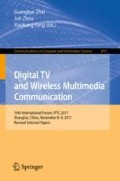Abstract
In this paper we address the problem of how to identify real 4K video contents from pseudo ones which were generated using complicated image post-processing technologies such as upsampling or super-resolution (SR). Two individual sets of 22 4K video sequences and 6 popular SR algorithms were collected for conducting this research. Despite the superior performance of current SR methods, they still not reach the perfect level since SR image reconstruction is a severely ill-posed problem and details are hard to be entirely recovered. This implies the reconstructed images based on SR methods do not conform to the natural scene statistics (NSS) model. According to this, we explore the difference of the locally normalized luminances’ distributions between real 4K video sequences and SR-generated pseudo 4K video sequences. It was shown by extensive tests that simple statistical features can be fused to form a good classifier for separating real 4K video contents from pseudo versions. Experimental results demonstrate that the proposed classier consumes less than a quarter of a second for a 4K video frame and the accuracy of classification is beyond 90%. abstract environment.
M. Liu—This work was supported in part by National Natural Science Foundation of China under Grants 61533002 and 61703009.
Access this chapter
Tax calculation will be finalised at checkout
Purchases are for personal use only
Notes
- 1.
More advanced upsampling or SR methods will be discussed later.
References
Wang, Z., Bovik, A.C., Sheikh, H.R., Simoncelli, E.P.: Image quality assessment: from error visibility to structural similarity. IEEE Trans. Image Process. 13(4), 600–612 (2004)
Yang, J., Wright, J., Huang, T.S., Ma, Y.: Image super-resolution via sparse representation. IEEE Trans. Image Process. 19(11), 2861–2873 (2010)
Zeyde, R., Elad, M., Protter, M.: On single image scale-up using sparse-representations. In: Boissonnat, J.-D., Chenin, P., Cohen, A., Gout, C., Lyche, T., Mazure, M.-L., Schumaker, L. (eds.) Curves and Surfaces 2010. LNCS, vol. 6920, pp. 711–730. Springer, Heidelberg (2012). https://doi.org/10.1007/978-3-642-27413-8_47
Timofte, R., De Smet, V., Van Gool, L.: Anchored neighborhood regression for fast example-based super-resolution. In: International Conference on Computer Vision, pp. 1920–1927, December 2013
Dong, C., Loy, C.C., He, K., Tang, X.: Image super-resolution using deep convolutional networks. IEEE Trans. Pattern Anal. Mach. Intell. 38(2), 295–307 (2016)
Ruderman, D.L.: The statistics of natural images. Netw. Comput. Neural Syst 5(4), 517–548 (1994)
Carandini, M., Heeger, D.J., Movshon, J.A.: Linearity and normalization in simple cells of the macaque primary visual cortex. J. Neurosci. 17(21), 8621–8644 (1997)
Sharifi, K., Leon-Garcia, A.: Estimation of shape parameter for generalized Gaussian distributions in subband decompositions of video. IEEE Trans. Circuits Syst. Video Technol. 5(1), 52–56 (1995)
Song, L., Tang, X., Zhang, W., Yang, X., Xia, P.: The SJTU 4K video sequence dataset. In: QoMEX, pp. 34–25, September 2013. http://medialab.sjtu.edu.cn/web4k/index.html
Marziliano, P., Dufaux, F., Winkler, S., Ebrahimi, T.: A no-reference perceptual blur metric. In: Proceedings IEEE International Conference on Image Process, vol. 3, pp. 57–60, September 2002
Ferzli, R., Karam, L.: A no-reference objective image sharpness metric based on the notion of just noticeable blur (JNB). IEEE Trans. Image Process. 18(4), 717–728 (2009)
Narvekar, N.D., Karam, L.J.: A no-reference image blur metric based on the cumulative probability of blur detection (CPBD). IEEE Trans. Image Process. 20(9), 2678–2683 (2011)
Vu, P., Chandler, D.: A fast wavelet-based algorithm for global and local image sharpness estimation. IEEE Signal Process. Lett. 19(7), 423–426 (2012)
Hassen, R., Wang, Z., Salama, M.: Image sharpness assessment based on local phase coherence. IEEE Trans. Image Process. 22(7), 2798–2810 (2013)
Gu, K., Zhai, G., Lin, W., Yang, X., Zhang, W.: No-reference image sharpness assessment in autoregressive parameter space. IEEE Trans. Image Process. 24(10), 3218–3231 (2015)
Gu, K., Zhai, G., Yang, X., Zhang, W.: Using free energy principle for blind image quality assessment. IEEE Trans. Multimed. 17(1), 50–63 (2015)
Gu, K., Zhou, J., Qiao, J., Zhai, G., Lin, W., Bovik, A.C.: Noreference quality assessment of screen content pictures. IEEE Trans. Image Process. 26(8), 4005–4018 (2017)
Gu, K., Zhai, G., Lin, W., Yang, X., Zhang, W.: Learning a blind quality evaluation engine of screen content images. Neurocomputing 196, 140–149 (2016)
Gu, K., Zhai, G., Yang, X., Zhang, W.: Hybrid no-reference quality metric for singly and multiply distorted images. IEEE Trans. Broadcast. 60(3), 555–567 (2014)
Zhai, G., Wu, X., Yang, X., et al.: A psychovisual quality metric in free-energy principle. IEEE Trans. Image Process. 21(1), 41–52 (2012)
Author information
Authors and Affiliations
Corresponding author
Editor information
Editors and Affiliations
Rights and permissions
Copyright information
© 2018 Springer Nature Singapore Pte Ltd.
About this paper
Cite this paper
Liu, M., Qiao, J., Wu, L., Zhang, H. (2018). How to Efficiently Identify Real and Pseudo 4K Video Contents?. In: Zhai, G., Zhou, J., Yang, X. (eds) Digital TV and Wireless Multimedia Communication. IFTC 2017. Communications in Computer and Information Science, vol 815. Springer, Singapore. https://doi.org/10.1007/978-981-10-8108-8_13
Download citation
DOI: https://doi.org/10.1007/978-981-10-8108-8_13
Published:
Publisher Name: Springer, Singapore
Print ISBN: 978-981-10-8107-1
Online ISBN: 978-981-10-8108-8
eBook Packages: Computer ScienceComputer Science (R0)

